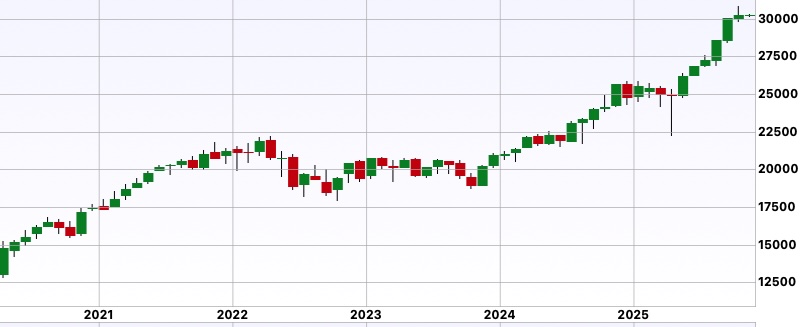Stock market language refers to two predominant patterns: “bulls” and “bears.” These terms describe the prevailing market trend and can sometimes cause concern, but understanding their meaning is key to maintaining a long-term perspective. My goal is to help you feel confident and calm about your investments, regardless of the market’s performance.
Let’s take a closer look at these two market cycles.
What is a Bull Market?
A bull market is a period of growth and momentum on the upside, characterized by generally rising stock prices. It fosters investor optimism, characterized by a positive outlook on the economy, where investors feel confident and eager to make purchases. Strong economic indicators and encouraging news typically coincide with a healthy economy, low unemployment rates, and rising corporate profits.
What is a Bear Market?
A bear market is the opposite: a period of declining stock prices, typically defined as a 20% or more drop from a recent high. It is a normal, though often unsettling, part of the market cycle, characterized by investor pessimism, where investors react to economic concerns and sell off assets. Bear markets are typically associated with an economic slowdown and rising unemployment rates.
Significant Bear Markets: We’ve also experienced considerable bear markets, such as the one during the Global Financial Crisis (2007–2009), and the sharp, yet brief downturn at the beginning of the COVID-19 pandemic in 2020. Despite their severity, substantial market recoveries followed.
The key takeaway from history is simple: bull markets have historically lasted much longer than bear markets, and a recovery and a new bull market have eventually followed every bear market, including the above-mentioned bear markets. The current summer markets of 2025 are at all-time highs.
Historical Context: Market Examples
Looking at historical data can be one of the most reassuring exercises for any investor. Market cycles are not new; they are a fundamental part of a healthy, growing economy.
Longest Bull Market: From 2009 to 2020, subsequent to the Global Financial Crisis, the S&P 500 experienced an 11-year bull run, one of the longest in history. The following graph illustrates the growth of the Canadian stock market (TSX) from 12,500 to 30,000, representing a phenomenal increase of over 100% in the current bull market over a five-year period. 1

Significant Bear Markets: We’ve also experienced considerable bear markets, such as the one during the Global Financial Crisis (2007–2009), and the sharp, yet brief downturn at the beginning of the COVID-19 pandemic in 2020. Despite their severity, substantial market recoveries followed.
The key takeaway from history is simple: bull markets have historically lasted much longer than bear markets, and a recovery and a new bull market have eventually followed every bear market, including the above-mentioned bear markets. The current summer markets of 2025 are at all-time highs.
How Do These Markets Affect Equity Mutual Funds?
For long-term investors, mutual funds are a powerful tool because they are inherently diversified. This built-in diversification is essential during volatile periods.
During a bull market, when the market is on the rise, your equity mutual funds can benefit directly from the overall growth, as the underlying stocks they hold increase in value.
During a bear market, while the value of your mutual funds will likely decrease, a long-term perspective is most valuable. Instead of seeing a loss, you can think of this period as an opportunity. Suppose you’re a regular investor through a Systematic Investment Plan (SIP). In that case, you are buying more fund units at a lower price. This strategy is known as “dollar-cost averaging”. It helps you accumulate more shares when the market is down, positioning you for greater returns when the market eventually rebounds.
Your mutual fund manager also plays a crucial role, making active decisions to manage risk and find new opportunities, even in a downturn.
The Bottom Line Market volatility is a regular part of investing. As an investor, your most significant advantage is your time horizon and your commitment to a well-thought-out plan. Trying to time the market—selling during a downturn out of fear and buying back in when things look better—is a common mistake that can lock in losses and cause you to miss out on the most significant gains during the recovery.
By focusing on your long-term goals and trusting in your diversified portfolio, you can weather these cycles with confidence. That’s what our partnership is all about: staying the course together.
1 Stock Spy


